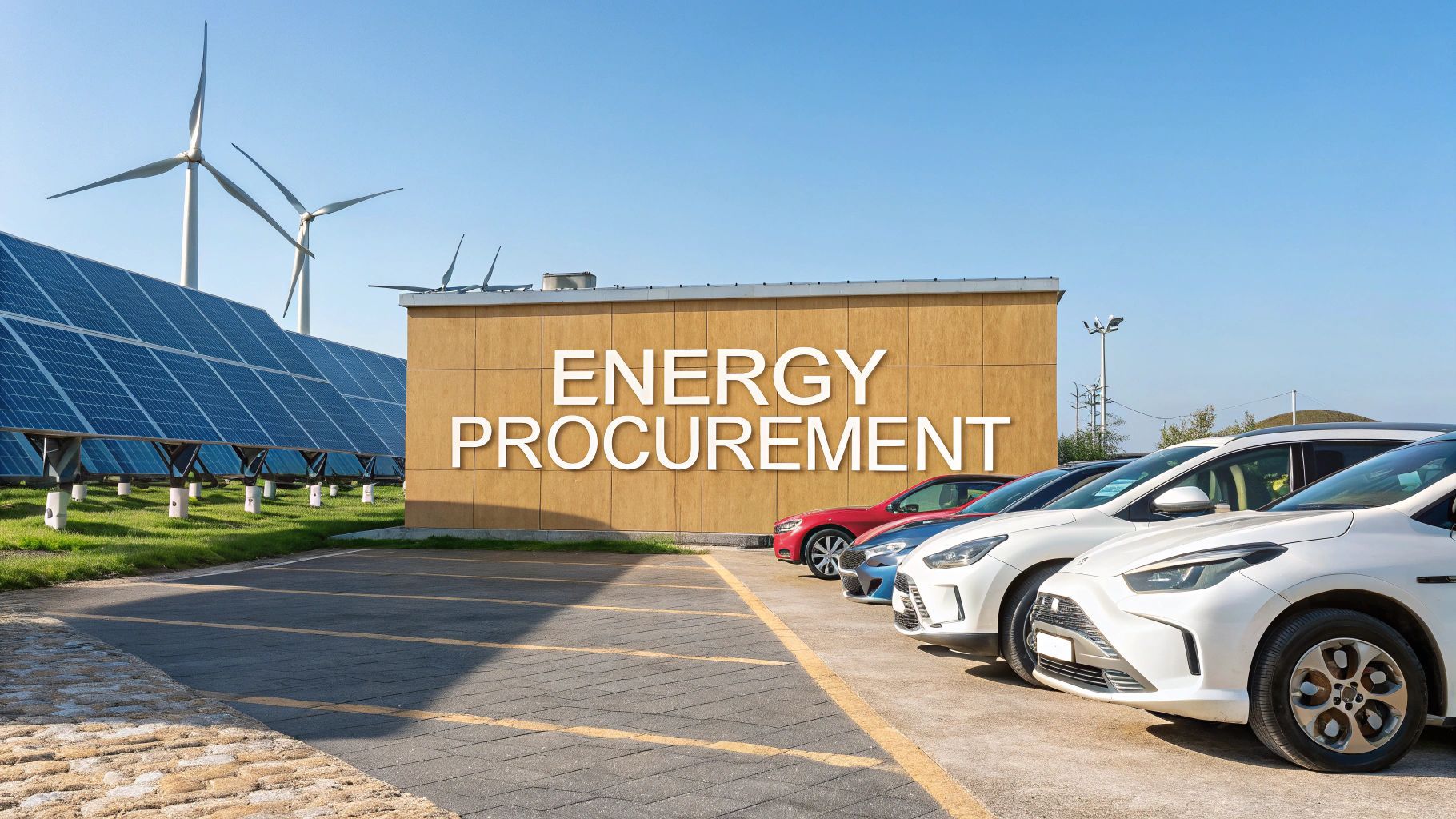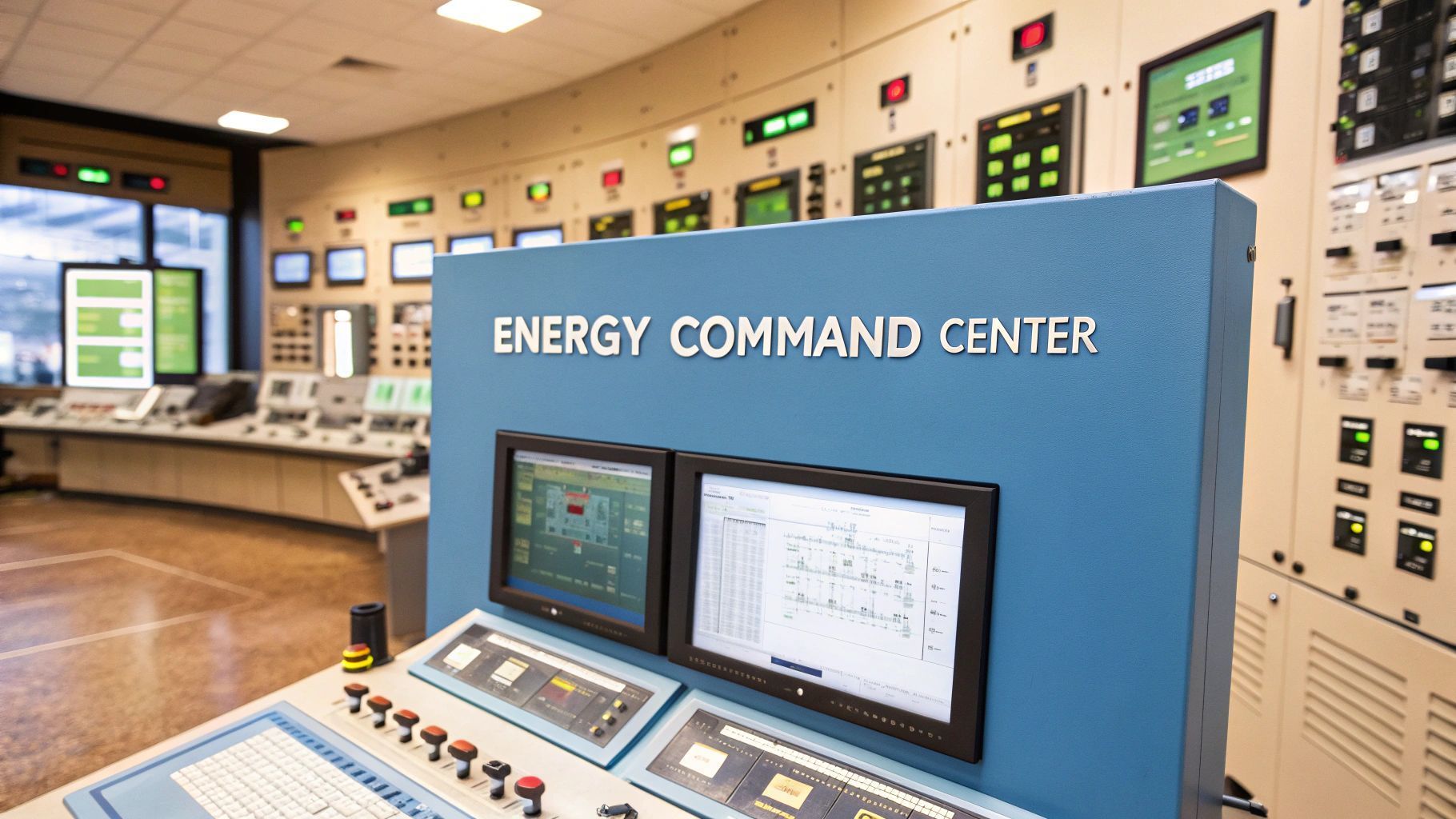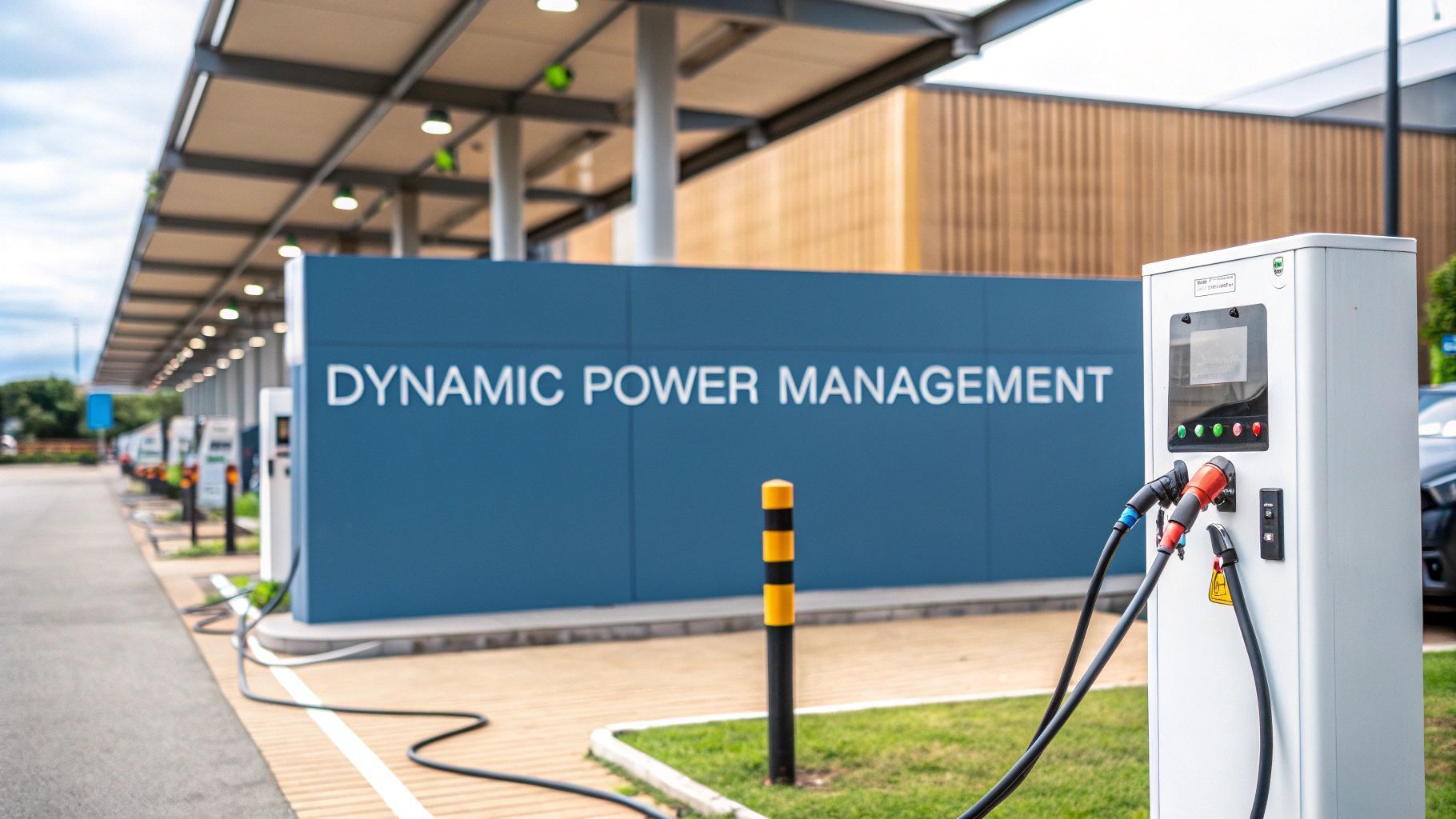Electric Plug Qatar: Your EV Charging Guide
If you're heading to Qatar, there's some good news about plugging in your devices. The country uses the Type G electric plug , which is the same chunky, three-pronged plug you'll find all over the United Kingdom.
That means if you're travelling from the UK you can leave your collection of travel adaptors at home. Your gadgets will fit right in.
Getting to Grips with Qatar's Electrical Standards
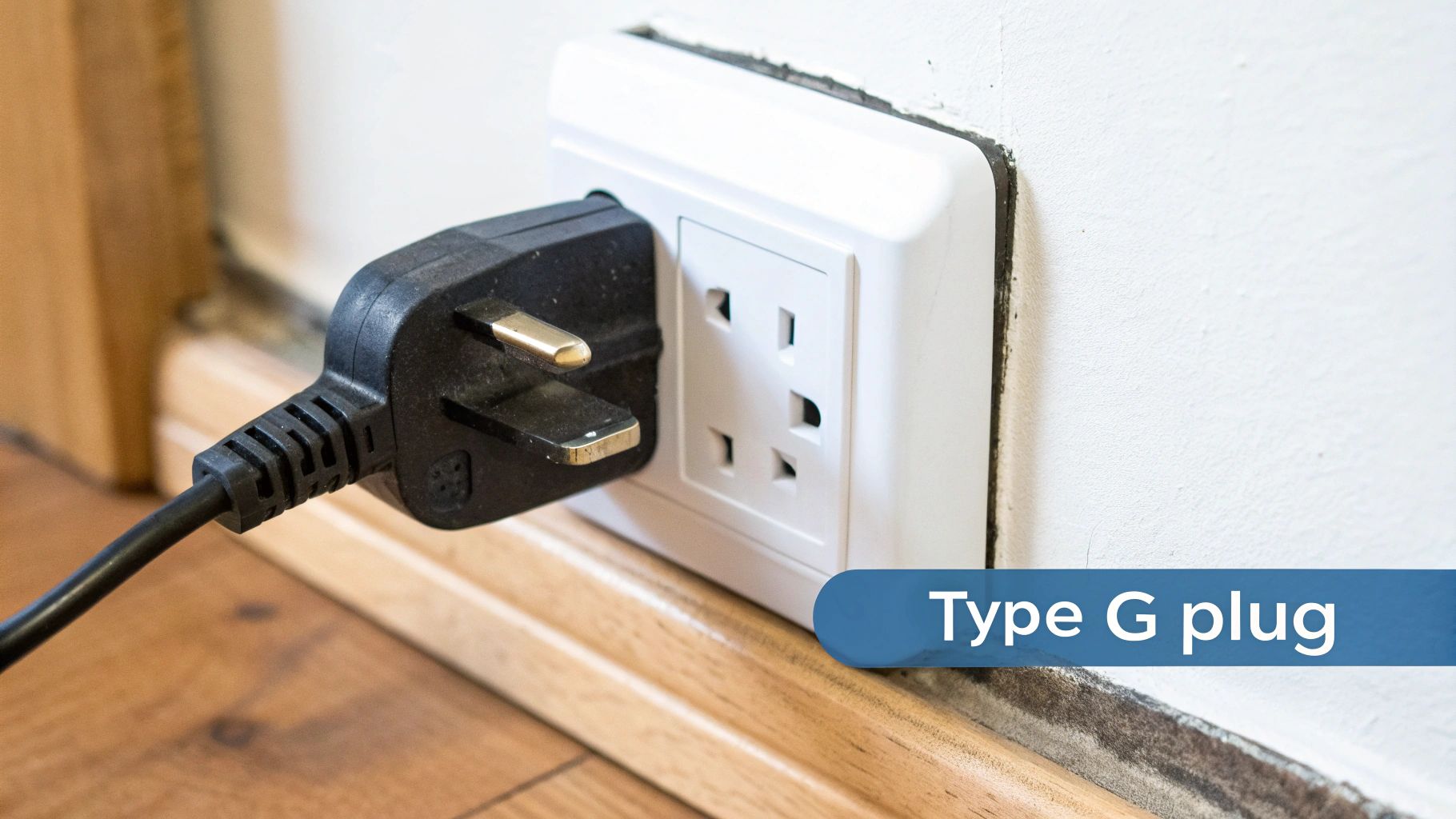
It’s not just the shape of the plug that matters. Qatar’s entire electrical system runs on a 240V voltage at a 50Hz frequency which perfectly matches the UK standard. This alignment makes life simple for many visitors, ensuring devices from laptops to hair dryers work just as they should.
The Type G plug wasn’t chosen by accident; it’s widely regarded as one of the safest designs in the world. Its story begins in post-war Britain which was looking to standardise a messy and often dangerous mix of different plug types. The result was the BS 1363 standard, introduced in 1947, which gave us the robust Type G plug we know today.
A Focus on Safety
So, what makes it so safe? A couple of clever design features are key and they’re a major reason why countries that prioritise electrical safety have adopted it.
- Internal Fuse: Every single Type G plug has its own fuse inside. Think of it as a tiny, personal circuit breaker for each appliance, protecting it from unexpected power surges.
- Shuttered Sockets: The wall sockets are designed with safety shutters. These block the holes for the live and neutral pins, only opening when the longer earth pin is inserted first. It's a simple but brilliant way to prevent accidental shocks, especially for curious children.
This commitment to a single, safe standard makes things straightforward. It’s a stark contrast to other parts of the world where you might encounter a confusing mix of socket types. As our guide to electric plugs in Chile for EV charging shows, knowing the local standard is always crucial before you travel.
Qatar Electrical Standards at a Glance
For a quick reference, here’s a simple breakdown of what you need to know about Qatar’s electrical setup.
| Specification | Standard in Qatar | Notes |
|---|---|---|
| Plug Type | Type G | The 3-pin rectangular plug, same as the UK. |
| Voltage | 240V | Compatible with devices from the UK and many other regions. |
| Frequency | 50Hz | Standard frequency that aligns with the UK and Europe. |
| Adaptor Needed? | Unlikely for UK travellers | Visitors from North America or Europe will need one. |
This table should give you all the essential information at a glance, helping you prepare for a hassle-free trip.
Why the Type G Plug Is a Global Safety Leader
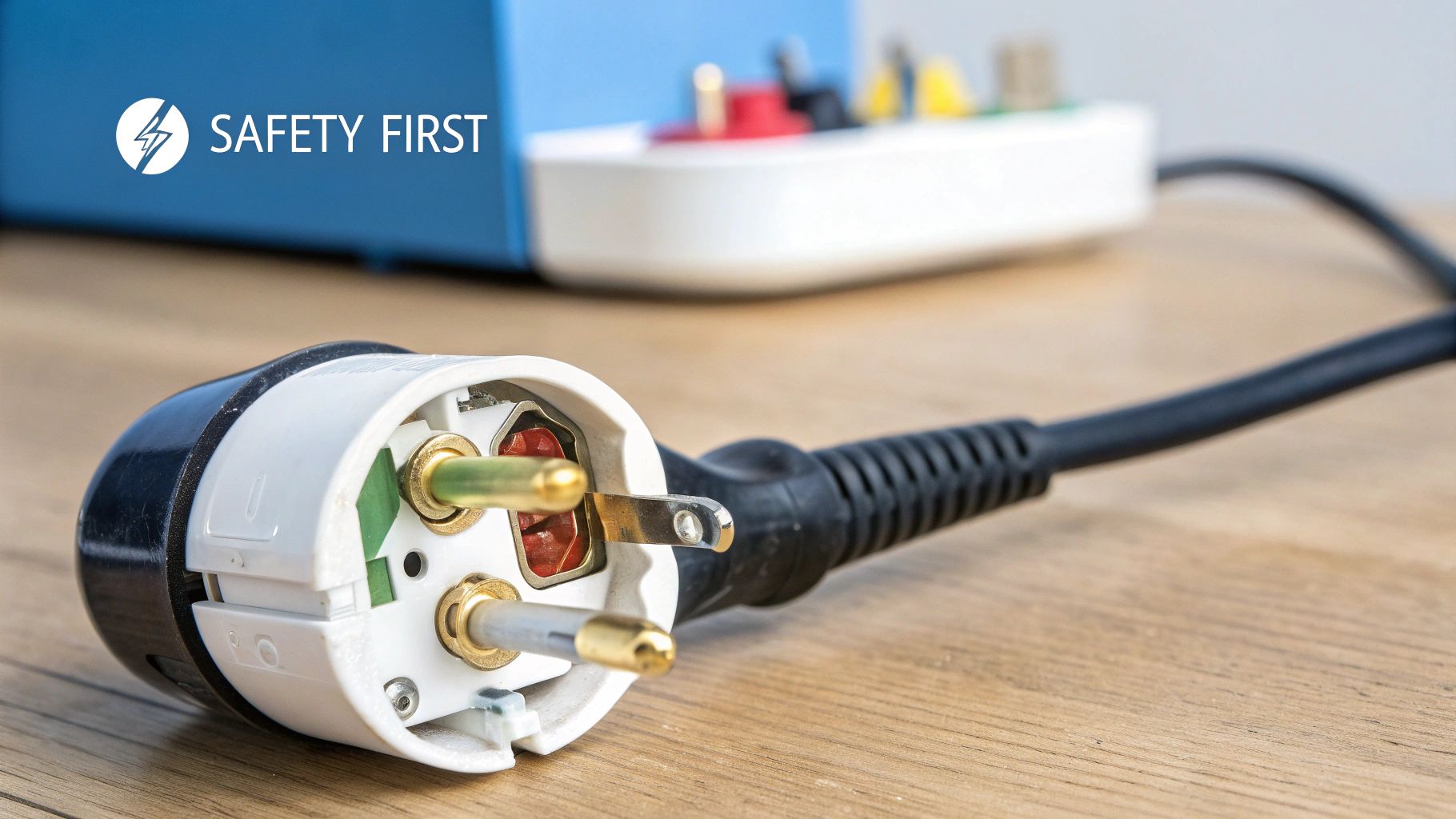
The choice of the Type G electric plug in Qatar wasn't a random decision. It's a deliberate move rooted in a serious commitment to electrical safety, adopting a design that comes straight from the British Standard BS 1363 — a global benchmark in safety engineering.
This world-class design didn't just appear overnight. The UK’s path to a safer plug began with a messy, fragmented system. A basic two-pin standard emerged in 1915 but the following decade saw a confusing mix of different plugs for various currents. It wasn't until the unified BS 1363 standard was introduced that things finally became orderly and, most importantly, safe.
It's this rich history of refinement that makes the Type G so trusted. Its features are meticulously engineered to prevent common electrical hazards, making it a rock-solid choice for homes and businesses alike.
Engineered for Maximum Protection
Two key features really set the Type G plug apart from many of its global counterparts. They work together to provide layers of protection that are baked right into the design.
-
An Internal Bodyguard: Every single Type G plug has its own built-in fuse. Think of it as a personal bodyguard for your appliance. If there’s a sudden power surge the fuse sacrifices itself by blowing, instantly cutting the electrical flow and saving your valuable electronics from getting fried.
-
A Clever Shutter System: The wall sockets themselves are fitted with an integrated safety shutter mechanism. This genius feature blocks access to the live and neutral contacts, stopping kids (and curious adults) from sticking foreign objects in. The shutters only open when the longer top earth pin is inserted first — a simple but incredibly effective safeguard against accidental electric shocks.
The combination of an internal fuse and a shuttered socket design makes the Type G plug one of the most secure domestic electrical systems in the world. This focus on safety is a primary reason for its adoption in Qatar.
These built-in safety measures offer genuine peace of mind. They represent a proactive approach to electrical safety, ensuring the connection between your device and the power grid is as secure as it can possibly be.
Using Your International Devices in Qatar
If you’re packing your bags for Qatar from somewhere like North America or most of Europe, you’ll need to give a little thought to your plugs. The Type G sockets used in Qatar are completely different so your devices simply won’t fit without a bit of help.
Luckily, it’s an easy fix. All you need is a simple travel adaptor to bridge the physical gap between your plug and the Qatari wall socket. You can pick these up easily at airports or electronics shops, either before you leave or once you land in Doha.
Adaptors Versus Converters
It’s really important to know the difference between a travel adaptor and a voltage converter . An adaptor just changes the shape of the plug pins while a converter actually changes the electrical voltage itself.
The good news for most of us is that a bulky, expensive voltage converter is rarely needed these days. Modern gadgets like your smartphone, tablet and laptop are almost always built with ‘dual voltage’ or ‘universal’ power supplies.
This means they can handle a whole range of voltages, usually from 100V to 240V , without any trouble. Just check the small print on your charger – if you see something like " INPUT: 100-240V " you’re all set to use it in Qatar with a simple plug adaptor. Getting your head around voltage is a key part of safe travel, a topic we dive into in our guide to voltage for Mexico and EV charging.
You might only need a converter for much older, single-voltage items like certain hair dryers or electric shavers but these are becoming less common. For nearly every international visitor to Qatar, a reliable travel adaptor is all you need to keep your essential tech charged and ready to go.
Powering the Future of Electric Vehicles in Qatar
While the familiar Type G plug is perfect for your kettle and toaster, Qatar's ambitious plans for electric transport call for something with a lot more muscle. The country is quickly rolling out a sophisticated EV charging network, moving far beyond standard wall sockets to a new breed of high-power connectors built for the future of driving.
This brings two new standards to the forefront that every EV owner—or prospective owner—in Qatar needs to get to grips with. For day-to-day AC charging at home or the office the Type 2 connector is the go-to standard. But when you need to add serious range, and fast, the Combined Charging System (CCS2) plug is king. This is the powerhouse behind Qatar's rapid DC charging network.
Navigating the EV Charging Network
It’s actually quite simple to tell them apart. Think of Type 2 charging like a steady trickle feed, perfect for topping up your battery overnight. CCS2 on the other hand is a powerful torrent of energy that can fill up an EV battery in a tiny fraction of the time. This dual-standard approach gives drivers the best of both worlds: everyday convenience and long-distance practicality.
This concept map gives a great visual for the basic idea of adapting a power source for different needs—a core principle in both travel adaptors and EV charging.
The image shows how a single point can connect to different systems, much like how EV chargers have to translate grid power into a format a car battery can use.
But Qatar’s vision isn't just about putting chargers everywhere. It's about building a smart, resilient energy ecosystem that can support a growing fleet of EVs without putting the national grid under strain. This forward-thinking strategy relies on a clever mix of technologies.
- Grid-Scale Batteries: These are huge energy storage systems that act like reservoirs. They store electricity when demand is low and release it for rapid EV charging during peak times, keeping the grid stable.
- On-Site Renewables: You’ll see many new charging hubs incorporating solar panels. This creates a clean, distributed energy source right where it’s needed, easing the load on the main grid.
- Mobile EV Charging: For ultimate flexibility, mobile charging units are being explored to bring power to remote spots or for special events, solving the problem of charging on the go.
By weaving together EV charging, battery storage and local renewables, Qatar is building a decentralised energy model. This doesn't just fuel electric transport; it strengthens the entire power infrastructure for a truly sustainable future.
Solving Grid Challenges with Advanced EV Charging
Powering an entire country's worth of electric vehicles is a huge undertaking, especially for a grid that's already expanding at a breakneck pace. This shift creates challenges that go far beyond the standard electric plug Qatar residents are familiar with, requiring some seriously smart solutions to keep the lights on. Qatar is diving headfirst into advanced strategies to support a massive EV rollout without overwhelming its power network.
The secret sauce lies in rethinking how energy is stored and delivered. At the heart of this new vision are technologies like grid-scale batteries . Think of them as giant power banks for the entire country. They soak up surplus electricity from the grid when demand is low—say, in the middle of the night—and then unleash it to power rapid EV charging stations when everyone needs a top-up during the day.
This approach is a brilliant way to smooth out the daily peaks and troughs in energy use, which ultimately creates a much more balanced and dependable grid for everyone.
Creating a Decentralised Energy System
To take stability to the next level, Qatar is also mixing on-site renewables with this energy storage. Picture a charging hub with its own solar panels and dedicated batteries—it’s a powerful combination. This kind of setup allows charging stations to generate and store their own clean electricity, making them far less reliant on the central grid.
This creates a distributed energy system where power is generated right where it’s needed. It's a more resilient and sustainable model that’s built to handle whatever the future throws at it. It’s a fascinating contrast to how some standards, like the UK's BS 1363 plug, remain unchanged for decades. That particular design has been a fixture in over 30 million British homes for more than 75 years.
This blend of rapid EV charging, battery storage and local renewables creates a resilient, decentralised energy network. It not only fuels the next generation of transport but also strengthens the entire power infrastructure for a sustainable future.
This integration is crucial for managing the intense demands of EV charging from constrained grid connections . By embracing these forward-thinking solutions including mobile EV charging and grid-scale batteries combined with on-site renewables , Qatar is building a blueprint for a clean, efficient and electric future.
Your Questions About Power in Qatar, Answered
Planning a trip or moving to Qatar? Let's clear up the most common questions about the country's electrical system. From plugs to EV charging, here are the straightforward answers you need.
What Kind of Plug Do I Need for Qatar?
You’ll need a Type G plug in Qatar. If you're coming from the UK you're in luck – it's the exact same three-pin rectangular plug you use at home. Your devices will fit straight into the wall sockets, no adaptor needed.
Is the Voltage in Qatar the Same as the UK?
Yes, it is. Qatar's power grid runs on a 240V supply at a 50Hz frequency which is a perfect match for the UK standard. This means your electronics will work just as they should without needing a voltage converter.
For visitors from outside the UK, most modern personal electronics like laptops and phone chargers are built to handle a range of voltages. Just check the small print on your charger – if it says '100-240V' all you’ll need is a simple Type G plug adaptor.
Key Takeaway: For UK travellers, Qatar's electrical system is a direct match. For everyone else, a simple Type G travel adaptor is usually all you'll need for your modern gadgets.
How Does EV Charging Work in Qatar?
When it comes to charging electric vehicles, the plugs are a bit different from what you find inside a home. Qatar's EV infrastructure is built around two key standards.
For everyday AC charging at public spots or at home the Type 2 connector is the standard. For those needing a quick top-up on major roads, the powerful CCS2 standard is used for rapid EV charging .
This growing network is often supported by smart technology like grid-scale batteries and renewable sources like solar panels. These systems store energy when demand is low and release it during peak times, creating a stable and sustainable power supply for the country’s expanding fleet of EVs. This smart use of EV charging and batteries and distributed energy is key to building a resilient charging ecosystem for the future.
At ZPN Energy , we’re not just following the future of energy infrastructure – we’re building it. From advanced rapid EV charging stations to sophisticated battery storage systems, we deliver the technology needed to power a cleaner, more sustainable world.
Find out more about our integrated energy solutions at https://www.zpnenergy.com.


